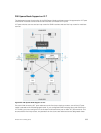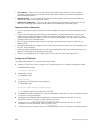
When the bandwidth usage drops below the 80% threshold, the system generates another syslog
message (shown in the following message) and an SNMP trap.
%STKUNIT0-M:CP %VLTMGR-6-VLT-LAG-ICL: Overall Bandwidth utilization of VLT-ICL-
LAG (port-channel 25)
reaches below threshold. Bandwidth usage (74 )VLT show remote port channel
status
VLT and IGMP Snooping
When configuring IGMP Snooping with VLT, ensure the configurations on both sides of the VLT trunk are
identical to get the same behavior on both sides of the trunk.
When you configure IGMP snooping on a VLT node, the dynamically learned groups and multicast router
ports are automatically learned on the VLT peer node.
VLT IPv6
The following features have been enhanced to support IPv6:
• VLT Sync — Entries learned on the VLT interface are synced on both VLT peers.
• Non-VLT Sync — Entries learned on non-VLT interfaces are synced on both VLT peers.
• Tunneling — Control information is associated with tunnel traffic so that the appropriate VLT peer can
mirror the ingress port as the VLT interface rather than pointing to the VLT peer’s VLTi link.
• Statistics and Counters — Statistical and counter information displays IPv6 information when
applicable.
• Heartbeat — You can configure an IPv4 or IPv6 address as a backup link destination. You cannot use
an IPv4 and an IPv6 address simultaneously.
VLT Port Delayed Restoration
When a VLT node boots up, if the VLT ports have been previously saved in the start-up configuration,
they are not immediately enabled.
To ensure MAC and ARP entries from the VLT per node are downloaded to the newly enabled VLT node,
the system allows time for the VLT ports on the new node to be enabled and begin receiving traffic.
The delay-restore feature waits for all saved configurations to be applied, then starts a configurable
timer. After the timer expires, the VLT ports are enabled one-by-one in a controlled manner. The delay
between bringing up each VLT port-channel is proportional to the number of physical members in the
port-channel. The default is 90 seconds.
To change the duration of the configurable timer, use the delay-restore command.
If you enable IGMP snooping, IGMP queries are also sent out on the VLT ports at this time allowing any
receivers to respond to the queries and update the multicast table on the new node.
This delay in bringing up the VLT ports also applies when the VLTi link recovers from a failure that caused
the VLT ports on the secondary VLT peer node to be disabled.
954
Virtual Link Trunking (VLT)


















